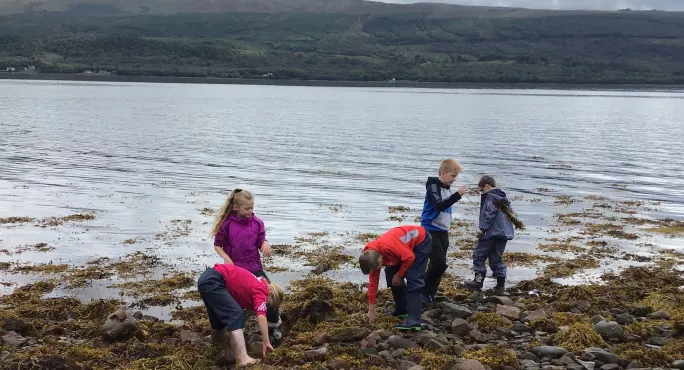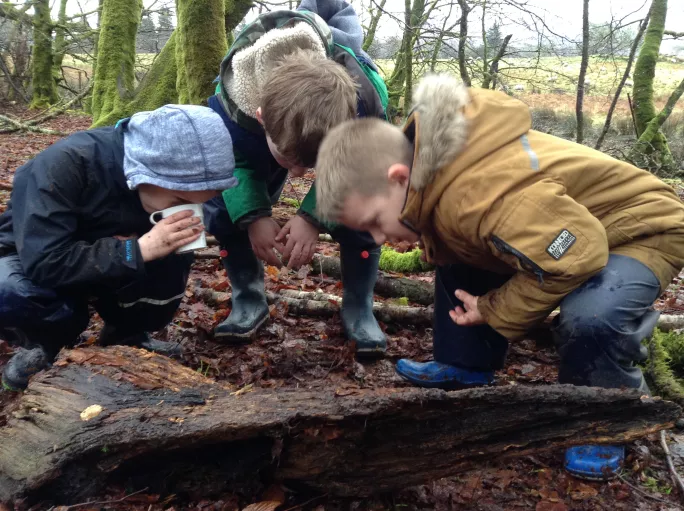- Home
- Teaching & Learning
- General
- Outdoor learning has improved our pupils’ attainment
Outdoor learning has improved our pupils’ attainment

This has been a school year unlike any other and has brought with it lots of challenges. Our primary school in Inveraray, a town of a few hundred people on the west coast of Scotland, has focused much of its post-lockdown work on outdoor learning and nurture.
Children here at early level experience 50 per cent of learning and play outdoors, those at first level have 33 per cent and second level children have a quarter of their school time outdoors. This has enabled the school to use a mixture of formal and informal learning outdoors to build in play-based and pupil-led learning, which, in turn, has helped to reduce anxiety and build resilience.
Outdoor learning comes in many shapes and sizes, from formal learning such as maths outdoors - where children survey plant and animal species to gather data - to child-led play experiences, where young people of all ages are able to follow their interests, evaluate risk and take charge.
Outdoor learning: Why Covid makes outdoor learning more essential than ever
Nurture in schools: What does a nurture approach look like?
Covid: ‘It’s time for all schools to head outdoors’
Policy: Outdoor play officially ‘fundamental’ to learning
When the pandemic started: 10 days that shook Scottish education
Lockdown: What’s life really like for pupils in lockdown?
Our Forest School (in the grounds of Argyll Estate) and Beach School (on the shore of Loch Fyne) provide opportunities for a blended experience. These lessons take place weekly over the course of a school term and are child-centred experiences where teachers set up learning “provocations” and options for activities ranging from den-building and mapping to creating artwork and storytelling.
Covid and schools: The value of outdoor learning
The young people have become very skilled at assessing risk, discussing how high to climb in different trees, facing fears and overcoming them to gain a sense of genuine success and confidence that spills over into other aspects of learning.
After the return to school in March, following the second lockdown in a year, staff noticed that children were finding some aspects of school more difficult than before. There were higher levels of anxiety, and children showed less resilience in their learning. Most had retained core knowledge in numeracy and literacy, but were having trouble applying or demonstrating it.
If a picture could define a school. pic.twitter.com/s1AaZBUemA
- Jay Helbert? (@learningjay) May 19, 2021
There was a temptation to abandon or reduce outdoor learning to focus on “the 3Rs” and fill more school time with maths and language. However, the school decided to play to its strengths and curriculum rationale by making the best use of its local and natural resources.
Learning outside has a range of benefits for learning. Psychoevolutionary theory tells us that merely being outside in natural environments changes how we feel. Children feel calmer, more optimistic and inspired.

This, in turn, means they are more successful at emotional regulation and social interaction. Relationships change, children are more ready to learn and they have a better-developed sense of self-worth.
These changes are not confined to the beach or the forest, but are then taken back to the classroom. The proof? This year attainment figures in literacy and numeracy are higher at Inveraray than they were pre-Covid and are higher than the national averages from the last ACEL (Achievement of Curriculum for Excellence Levels) data collection in 2019.
This is not despite a focus on outdoor learning - but because of it.
Jay Helbert is headteacher at Inveraray Primary School and lead for active pedagogies and outdoor learning at Argyll and Bute Council
You need a Tes subscription to read this article
Subscribe now to read this article and get other subscriber-only content:
- Unlimited access to all Tes magazine content
- Exclusive subscriber-only stories
- Award-winning email newsletters
Already a subscriber? Log in
You need a subscription to read this article
Subscribe now to read this article and get other subscriber-only content, including:
- Unlimited access to all Tes magazine content
- Exclusive subscriber-only stories
- Award-winning email newsletters



